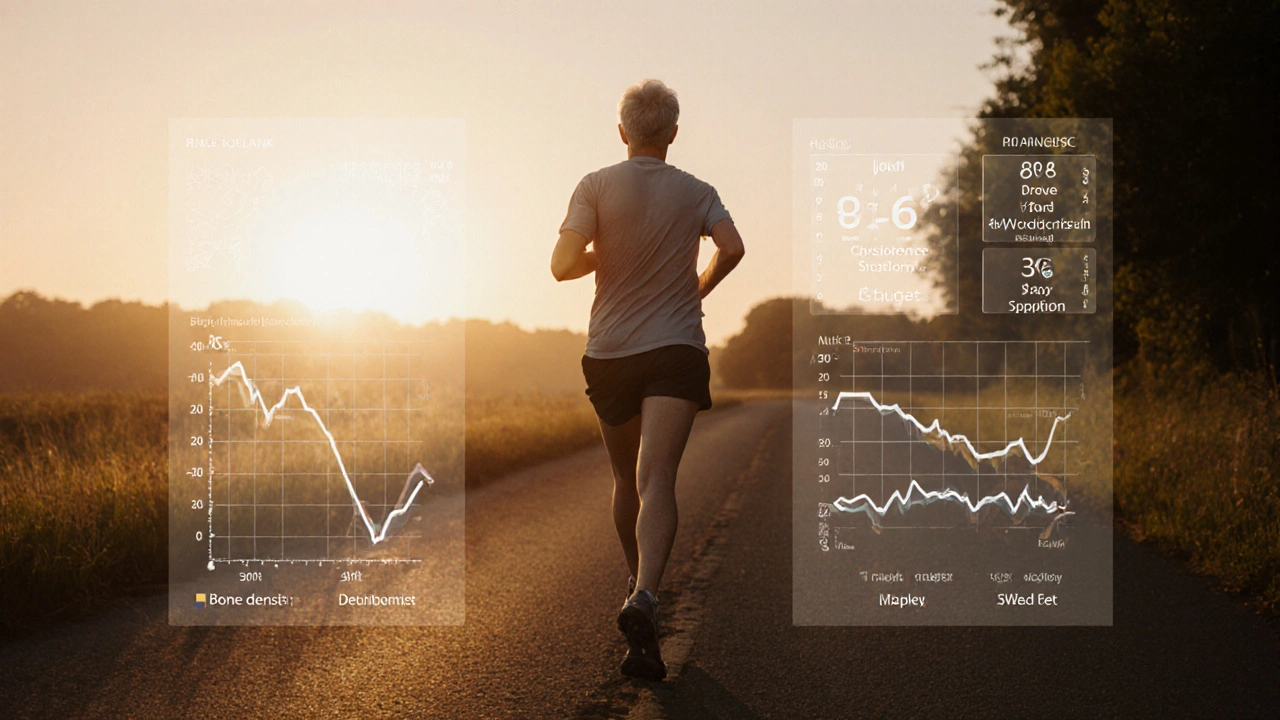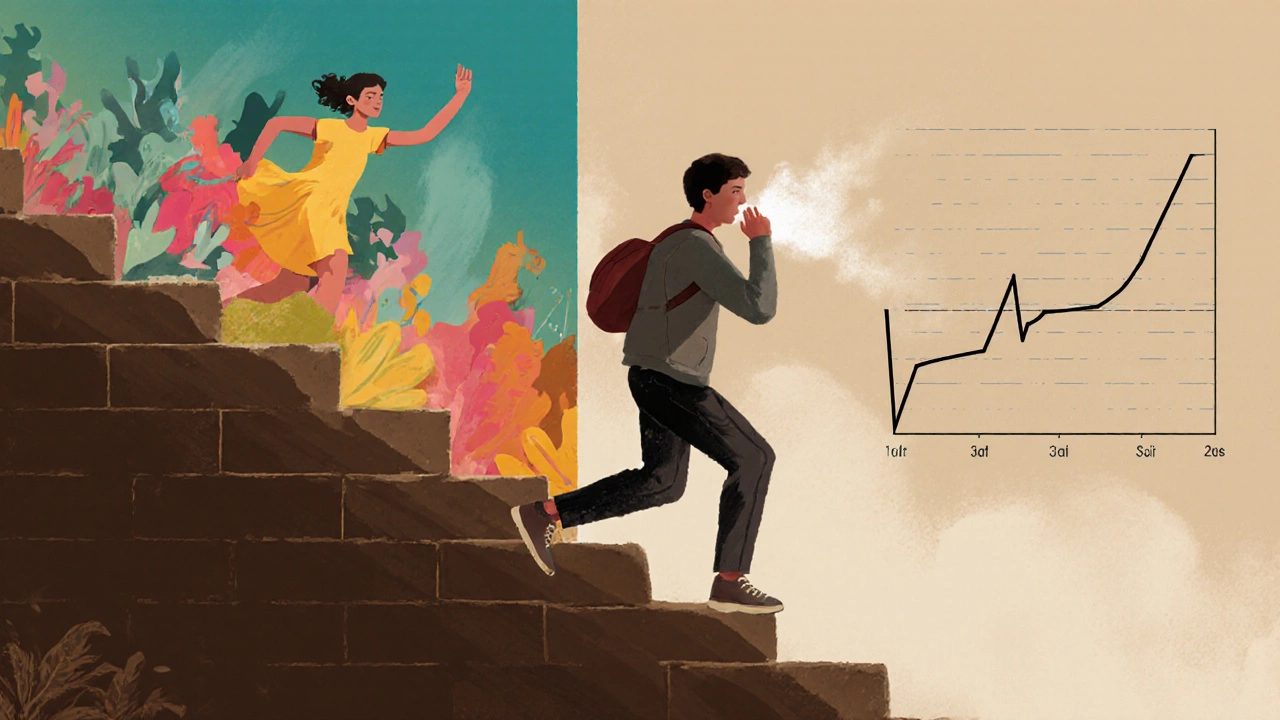At What Age Do Humans Start Declining? The Real Signs and When They Really Begin

Aging Decline Risk Calculator
Discover how your current habits impact your aging process. Based on research from the article "At What Age Do Humans Start Declining?".
Assess Your Lifestyle
Answer these quick questions to get your personalized decline risk assessment.
Your Results
Answer questions above to see your personalized assessment
Most people assume aging means slow, steady decline-like a car losing power after 100,000 miles. But here’s the truth: humans don’t start declining at one specific age. We lose things at different times, in different ways, and some of it starts earlier than you think.
Your 20s: The Quiet Start
By your mid-20s, your body is already changing-just not in ways you notice. Bone density peaks around 25. Muscle mass starts a slow, silent drop after 27. Your metabolism slows by about 2% per decade after 20. These aren’t dramatic changes. You won’t feel weaker lifting groceries. But if you compare your 25-year-old self to your 35-year-old self, you’ll notice you recover slower after a workout. You need more sleep. You don’t bounce back the same way.
Brain changes begin here too. Processing speed peaks around 20 and starts to decline gently. Working memory-holding numbers in your head, recalling a name you just heard-gets a little less reliable after 25. This isn’t memory loss. It’s efficiency loss. Your brain still stores everything. It just takes a little longer to find it.
Your 30s: The First Real Shift
By 30, your body starts prioritizing survival over performance. Hormones like testosterone and estrogen begin a slow, steady drop. Testosterone in men falls about 1% per year after 30. In women, estrogen dips around perimenopause, often starting in the late 30s. These changes affect energy, mood, and muscle retention.
Physical recovery takes longer. A weekend hike doesn’t feel like a fun challenge anymore-it feels like a chore you have to plan for. You wake up stiff. You need more time to heal from a pulled muscle. You start skipping the gym not because you’re lazy, but because your body asks for more rest.
Visually, you might notice the first wrinkles. Not because you’re old, but because collagen production drops by about 1% per year after 20. Your skin still looks good. But if you squint at old photos, you’ll see the difference.
Your 40s: The Wake-Up Call
By 40, the changes become harder to ignore. You’re not just slower-you’re different. Your body is no longer compensating for small losses. It’s starting to reveal what’s been missing.
Cardiovascular fitness drops noticeably. Your VO2 max-the maximum amount of oxygen your body can use during exercise-declines by about 10% per decade after 30. You can’t run as far or as fast without gasping. Your resting heart rate creeps up. You feel winded climbing stairs that used to be easy.
Cognitive changes become more obvious. Multitasking gets harder. You forget where you put your keys. You walk into a room and forget why. These aren’t signs of dementia. They’re signs of attention overload. Your brain is juggling more than ever-kids, work, bills, aging parents-and it’s running on less mental bandwidth.
And then there’s sleep. You used to crash after a long day and sleep through the night. Now you wake up at 3 a.m. and can’t go back. This isn’t just stress. It’s your circadian rhythm shifting. Melatonin production drops. Your body’s internal clock is resetting.

Your 50s and Beyond: The Reality Check
By 50, most people have experienced at least one major physical shift: joint pain, reduced vision, hearing loss, or a diagnosis like prediabetes or high blood pressure. These aren’t inevitable. But they’re common.
Strength declines faster than you think. After 50, you lose 1-2% of muscle mass per year if you don’t lift weights. That adds up. By 70, you might have lost 30% of your muscle. That doesn’t just make you weaker-it makes you more likely to fall, break a hip, or lose independence.
Cognitive decline becomes more measurable. Memory tests show slower recall. Reaction times drop. But here’s the twist: wisdom and emotional regulation improve. Your brain becomes better at reading social cues, managing stress, and choosing what to care about. You’re less reactive. You’re more resilient. That’s not decline. That’s adaptation.
What Declines? What Doesn’t?
Not everything gets worse. Some things get better.
- Emotional intelligence keeps rising through your 60s and beyond. You handle conflict better. You care less about what others think.
- Problem-solving improves. You’ve seen patterns before. You know what works.
- Life satisfaction often peaks in your late 60s. Studies show people over 65 report higher happiness than those in their 30s.
- Knowledge keeps growing. Vocabulary, cultural awareness, practical skills-these don’t fade unless you stop learning.
The real question isn’t “When do you start declining?” It’s “What do you do about it?”
It’s Not About Age. It’s About Habits.
Two 65-year-olds can look completely different. One is stiff, tired, and forgetful. The other is strong, sharp, and full of energy. The difference? Movement.
People who lift weights twice a week after 40 keep nearly all their muscle. Those who walk 10,000 steps a day keep their heart strong. Those who read, learn new skills, or play music keep their brain active.
One study from the University of California followed 1,000 people for 20 years. Those who exercised regularly, ate whole foods, slept 7+ hours, and stayed socially connected had cognitive function equivalent to people 10 years younger. They didn’t avoid aging. They slowed it down.
Strength training is the most powerful tool against decline. It doesn’t just build muscle. It protects bones, improves insulin sensitivity, boosts mood, and even helps memory. You don’t need to be an athlete. Just 20 minutes, twice a week, makes a difference.
So if you’re 30 and wondering if it’s too late to start-no. If you’re 50 and think you’re too old to change-wrong. Your body doesn’t care how old you are. It only cares what you ask it to do.

When Should You Worry?
Normal aging isn’t the enemy. Sudden changes are.
If you suddenly forget how to use a familiar appliance, can’t remember close family names, or lose balance without injury, that’s not aging. That’s a signal. Same with unexplained weight loss, constant fatigue, or confusion that doesn’t clear up.
Don’t panic. But don’t ignore it either. See a doctor. Get tested. These aren’t signs of inevitable decline-they’re signs you need help.
What You Can Control
You can’t stop time. But you can control how you spend it.
- Movement: Walk daily. Lift weights twice a week. Dance. Swim. Just move.
- Nutrition: Eat more vegetables, legumes, nuts, and fish. Cut back on sugar and ultra-processed foods.
- Sleep: Aim for 7-8 hours. Keep a consistent schedule.
- Connection: Talk to people. Join a group. Volunteer. Loneliness ages you faster than smoking.
- Learning: Pick up a language. Play chess. Read nonfiction. Your brain needs novelty.
Decline isn’t a cliff. It’s a slope. And you get to decide how steep it is.
Is cognitive decline inevitable as you get older?
No, cognitive decline isn’t inevitable. While processing speed and short-term memory slow down naturally, skills like vocabulary, emotional understanding, and problem-solving often improve with age. People who stay mentally active-reading, learning new things, solving puzzles-maintain sharper brains longer. Studies show lifelong learners have up to 30% lower risk of dementia.
At what age do physical abilities start to drop noticeably?
Noticeable drops in physical performance usually begin in your 40s. Strength, endurance, and recovery speed decline gradually after 30, but most people start feeling it in their 40s-especially if they’re inactive. VO2 max drops about 10% per decade after 30, and muscle mass declines by 1-2% per year after 50 without resistance training.
Can you reverse aging signs after 50?
You can’t reverse aging, but you can reverse many of its effects. People over 50 who start strength training gain muscle, improve balance, lower blood pressure, and boost mood within months. Sleep quality, energy levels, and mental clarity often improve dramatically with consistent exercise, better nutrition, and stress management-even in your 60s and 70s.
Does diet play a big role in slowing decline?
Yes. Diets rich in vegetables, fruits, whole grains, nuts, fish, and olive oil-like the Mediterranean diet-are linked to slower cognitive decline and lower risk of heart disease and diabetes. Cutting back on sugar, refined carbs, and processed foods reduces inflammation, which speeds up aging. Eating well doesn’t stop aging, but it helps you age better.
Is it too late to start healthy habits if I’m already 60?
It’s never too late. A 2023 study in the British Journal of Sports Medicine found that people who started exercising regularly after 60 reduced their risk of early death by 35% over the next 10 years. Strength training improved mobility, reduced falls, and boosted mental health. Starting at 60 isn’t late-it’s a second chance.
Final Thought
You’re not declining because you’re getting older. You’re declining because you stopped moving, stopped learning, stopped connecting. The body adapts to what you demand of it. If you sit, you weaken. If you challenge it, it fights back.
Age isn’t the enemy. Inaction is.
